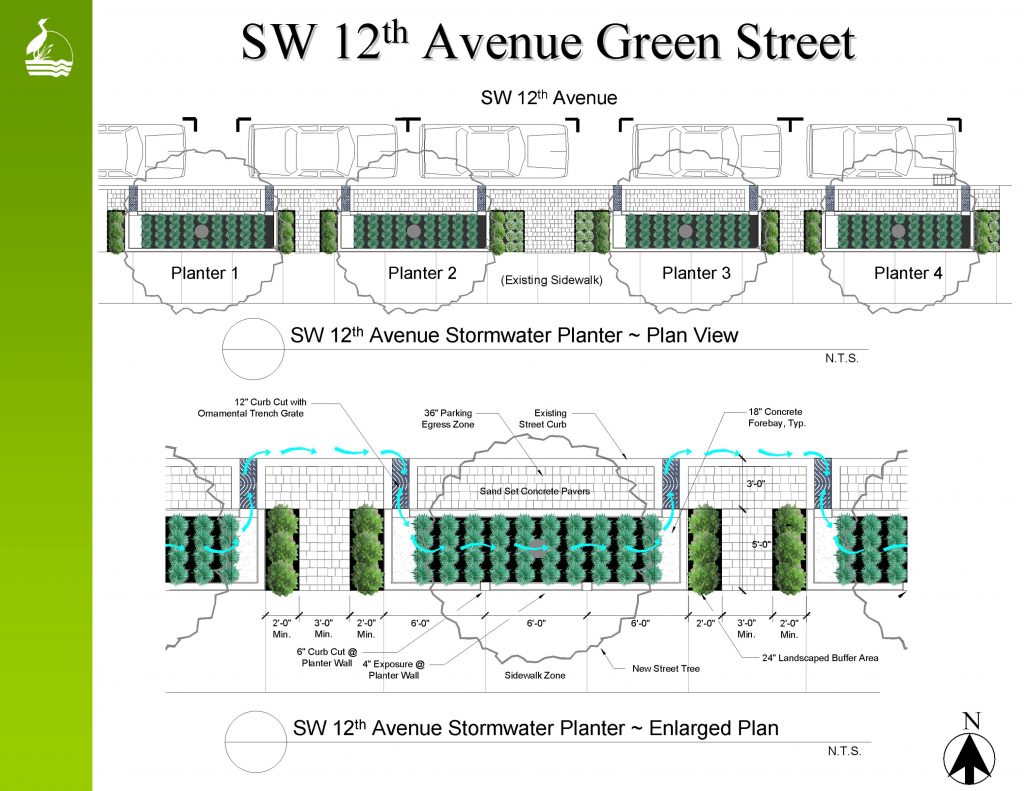Stormwater planter
This tool for storing and treating rainwater has the form of a concrete box (the garden can also be made of stone or brick) with an open bottom. Thus, it is a small space for storing rainwater, which then infiltrates the native soil. Its size (capacity, volume) should be adapted to the amount of space in a given area, as well as the expected volume of rainwater in a given area. Depth from 22 to 30 cm. The water in the pot should stay not be longer than 24 to 36 hours.
Environmental benefits: rainwater retention, reduction of surface runoff from hard-surfaced pavements, parking lots or streets, rainwater purification (sedimentation of pollutants, phytoremediation), as well as – increasing biodiversity in the city, creating new habitats for fauna.
Social benefits: educational aspects, decorative aspects.
Economic benefits: reduction of the cost of rainwater discharge to the storm sewage system. (and reducing possible overloads of this system during torrential rainfall events)
They are part of creating green networks in the city: together with green roofs, green walls, rain gardens, bioswales.
The solution can be used by local communities and professionals.
Construction:
The solution is in the form of a concrete pot with an open bottom. An important component of this solution is a properly prepared substrate consisting of several layers.
Layer 1 – mulch. The bark mulch controls soil temperature as well as seed germination, which protects the space from the appearance of unwanted weeds (it can be replaced with wood shavings as well as coarse compost).
Layer 2 – soil (it is recommended to put crushed rock or geotextile between the individual layers of soil to prevent mixing of the individual layers of the soil, which allows the drainage to be kept open). The native soil can also be replaced with mixtures with a better infiltration rate (e.g. 60% sandy loam and 40% compost), the soil pH should be between 5.5 and 7.5.
Layer 3 – roots of plants that assimilate pollutants (heavy metal compounds, petroleum compounds, nitrogen or phosphorus, organic compounds, and numerous bacteria).
Layer 4 – a drainage system that allows water to get into the native soil. The water does not have to be discharged from the reservoir directly into the native soil, but elsewhere, in this case the bottom should be sealed and an appropriate drainage system should be used – such solutions will help us to protect, for example, the foundations of a given building.
Purposely selected plant species grow in the pot, which are supposed to, among other things, purify water from pollutants. It is important to properly select the species and plant them at a certain distance from the concrete foundations. They must be adapted to the existing environmental conditions (it is preferable to choose native species, which will enable the creation of local ecosystems), and they must not require too complex and costly agricultural practices. The space should also visually harmonize with the surroundings. After planting in a container, you should wait about 3 months for the system to start operating so that the plants to take root fully.
Maintenance:
– Agricultural practices to maintain good plant material condition, including replacement of vegetation according to the needs.
– Review of the structure of the facility, replacement of concrete components, if necessary.
– Cleaning the rainwater inflow and outflow mechanisms.
– Study of the amount of pollutants in the mulch.
An example of a set of plants to be used:
| Andropogon gerardii | Muhlenbergia reverchonii | Helianthus maximiliana |
| Camassia leichtlinii | Sporobolus heterolepis | Ratibida pinnata |
| Liatris ligulistylis | Schizachyrium scoparium | Amorpha canescens |
| Monarda fistulosa | Anaphalis margaritacea | Calamagrostis × acutiflora |
Based on: https://www.denvergov.org/files/assets/public/doti/documents/standards/pwes-013.0-ultra_urban_green_infrastructure_guide.pdf
Example:
SW 12th Avenue Green Street Project, Portland.
The project of a network of rainwater stormwater planters at 12th Avenue Green Street in Portland was created as part of the creation of the so-called green street. This pioneering project shows how to design rainwater retention components in a compact urban fabric.
The designed planters accumulate water (water infiltrates the ground at a rate of 10 cm per hour), which flows down from an area of 2430 m2. Water flows down a specially profiled curb, in planters it reaches a maximum of 15 cm. When the planters is full, the excess water under the street is transported to the next planters until it is fully filled, and the excess water is then sent to the sewage system. (The system is adapted to 25-year-old storms – absorbing water at the level of 70%).
An important component of the system is the vegetation used here, which purifies rainwater.
It is estimated that currently all rainwater is absorbed by the system.



References
https://www.brookings.or.us/DocumentCenter/View/668/Planning—Stormwater-Planters-PDF?bidId=
https://www.cleanwaterservices.org/media/2165/flow-through-planter.pdf
https://www.denvergov.org/files/assets/public/doti/documents/standards/pwes-013.0-ultra_urban_green_infrastructure_guide.pdf
https://catalog.extension.oregonstate.edu/sites/catalog/files/project/pdf/em9213.pdf
https://www.semswa.org/uploads/FileLinks/c6620187922a4bd3a0281b7fa73439da/Stormwater_Planters_Fact_Sheet.pdf
https://nacto.org/docs/usdg/stormwater_planter_crwa.pdf
